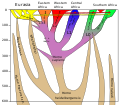File:Homo lineage 2017update.svg
出典:ウィキメディア・コモンズ (Wikimedia Commons)
ナビゲーションに移動
検索に移動

この SVG ファイルのこの PNG プレビューのサイズ: 675 × 498 ピクセル. その他の解像度: 320 × 236 ピクセル | 640 × 472 ピクセル | 1,024 × 755 ピクセル | 1,280 × 944 ピクセル | 2,560 × 1,889 ピクセル。
元のファイル (SVG ファイル、675 × 498 ピクセル、ファイルサイズ: 21キロバイト)
ファイル情報
構造化データ
キャプション
キャプション
このファイルの内容を1行で記述してください
概要[編集]
| 解説Homo lineage 2017update.svg |
English: phylogeny of the Homo genus, based on Stringer, C. (2012). "What makes a modern human". Nature 485 (7396): 33–35. doi:10.1038/485033a, with modifications.
The following features are based on Stringer (2012).
Modifications based on other publications:
|
| 日付 | |
| 原典 | updated version of File:Homo-Stammbaum, Version Stringer-en.svg |
| 作者 | User:Conquistador, User:Dbachmann |
| その他のバージョン |
|
ライセンス[編集]
このファイルはクリエイティブ・コモンズ 表示-継承 4.0 国際ライセンスのもとに利用を許諾されています。
- あなたは以下の条件に従う場合に限り、自由に
- 共有 – 本作品を複製、頒布、展示、実演できます。
- 再構成 – 二次的著作物を作成できます。
- あなたの従うべき条件は以下の通りです。
- 表示 – あなたは適切なクレジットを表示し、ライセンスへのリンクを提供し、変更があったらその旨を示さなければなりません。これらは合理的であればどのような方法で行っても構いませんが、許諾者があなたやあなたの利用行為を支持していると示唆するような方法は除きます。
- 継承 – もしあなたがこの作品をリミックスしたり、改変したり、加工した場合には、あなたはあなたの貢献部分を元の作品とこれと同一または互換性があるライセンスの下に頒布しなければなりません。
ファイルの履歴
過去の版のファイルを表示するには、その版の日時をクリックしてください。
| 日付と時刻 | サムネイル | 寸法 | 利用者 | コメント | |
|---|---|---|---|---|---|
| 現在の版 | 2017年12月20日 (水) 11:02 |  | 675 × 498 (21キロバイト) | Dbachmann (トーク | 投稿記録) | |
| 2017年12月20日 (水) 09:27 |  | 675 × 498 (20キロバイト) | Dbachmann (トーク | 投稿記録) | ||
| 2017年12月20日 (水) 08:54 |  | 675 × 498 (19キロバイト) | Dbachmann (トーク | 投稿記録) | {{Information |Description= |Source= |Date= |Author= |Permission= |other_versions= }} | |
| 2017年12月19日 (火) 10:44 |  | 561 × 465 (16キロバイト) | Dbachmann (トーク | 投稿記録) | User created page with UploadWizard |
このファイルは上書きできません。
ファイルの使用状況
以下の 21 ページがこのファイルを使用しています:
- User:Sobreira
- File:Hominini lineage.svg
- File:Hominoidea lineage.svg
- File:Homo-Stammbaum, Version Stringer-en.svg
- File:Homo-Stammbaum, Version Stringer-ko.svg
- File:Homo lineage 2017update.svg
- File:Homo sapiens lineage.svg
- File:Human evolution chart-bg.svg
- File:Human evolution chart-el.svg
- File:Human evolution chart-en.svg
- File:Human evolution chart-fa.svg
- File:Human evolution chart-fr.svg
- File:Human evolution chart-he.svg
- File:Human evolution chart-hr.svg
- File:Human evolution chart-it.svg
- File:Human evolution chart-sv.svg
- File:Human evolution chart-tr.png
- File:Human evolution chart-tr.svg
- File:Human evolution chart-uk.svg
- File:Humanevolutionchart.svg
- Template:Other versions/Human evolution chart
グローバルなファイル使用状況
以下に挙げる他のウィキがこの画像を使っています:
- af.wikipedia.org での使用状況
- cs.wikipedia.org での使用状況
- en.wikipedia.org での使用状況
- es.wikipedia.org での使用状況
- eu.wikipedia.org での使用状況
- fa.wikipedia.org での使用状況
- id.wikipedia.org での使用状況
- ja.wikipedia.org での使用状況
- pl.wikibooks.org での使用状況
- pt.wikipedia.org での使用状況
- ro.wikipedia.org での使用状況
- ru.wikipedia.org での使用状況
- te.wikipedia.org での使用状況
- vi.wikipedia.org での使用状況
メタデータ
このファイルには、追加情報があります (おそらく、作成やデジタル化する際に使用したデジタルカメラやスキャナーが追加したものです)。
このファイルが元の状態から変更されている場合、修正されたファイルを完全に反映していない項目がある場合があります。
| 画像の幅 | 675.15759 |
|---|---|
| 画像の高さ | 498.24149 |




